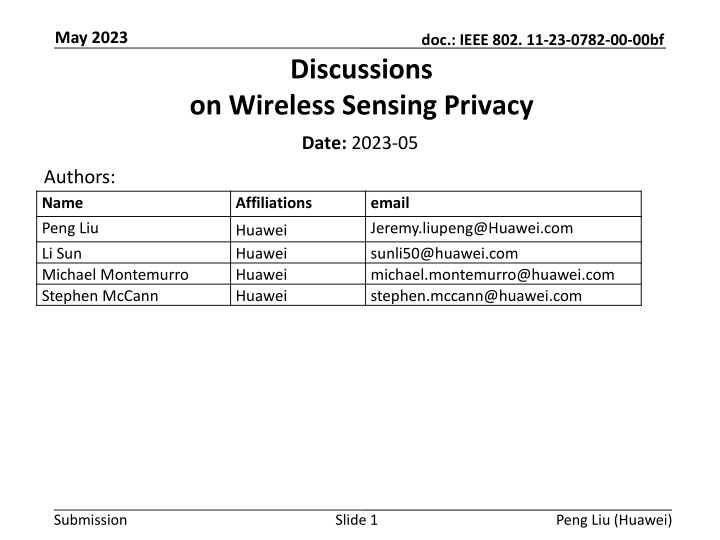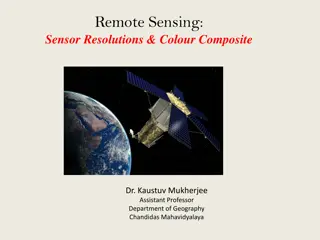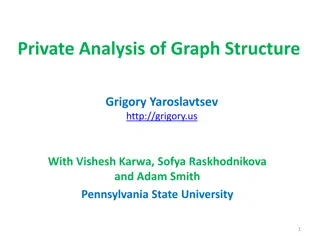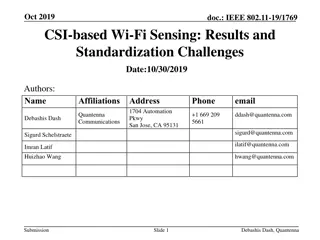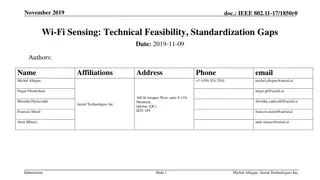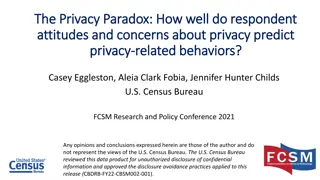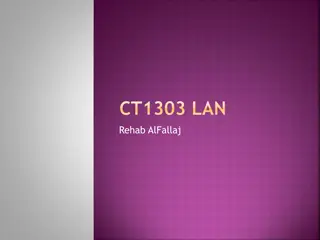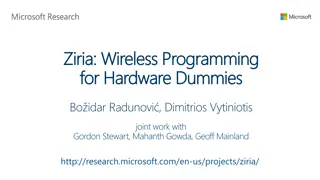Wireless Sensing Privacy Discussions in May 2023 Document
May 2023 document (.IEEE 802..11-23-0782-00-00bf) discusses privacy issues related to wireless sensing, including unauthorized access to sensing reports, tracking of sensing devices, and potential eavesdropping on sensing signals. It proposes solutions to protect sensitive information and addresses unique privacy challenges in wireless sensing technology.
Download Presentation

Please find below an Image/Link to download the presentation.
The content on the website is provided AS IS for your information and personal use only. It may not be sold, licensed, or shared on other websites without obtaining consent from the author.If you encounter any issues during the download, it is possible that the publisher has removed the file from their server.
You are allowed to download the files provided on this website for personal or commercial use, subject to the condition that they are used lawfully. All files are the property of their respective owners.
The content on the website is provided AS IS for your information and personal use only. It may not be sold, licensed, or shared on other websites without obtaining consent from the author.
E N D
Presentation Transcript
May 2023 doc.: IEEE 802. 11-23-0782-00-00bf Discussions on Wireless Sensing Privacy Date: 2023-05 Authors: Name Affiliations email Peng Liu Jeremy.liupeng@Huawei.com Huawei Huawei Huawei Huawei Li Sun Michael Montemurro Stephen McCann sunli50@huawei.com michael.montemurro@huawei.com stephen.mccann@huawei.com Submission Slide 1 Peng Liu (Huawei)
May 2023 doc.: IEEE 802. 11-23-0782-00-00bf Outline Wireless sensing privacy issues Discussions within other SDOs 3GPP (Release 19) IEEE 802.15.4ab (NG-UWB) IEEE 802.11az solution (secure LTF + 64QAM) Potential solutions Summary Submission Slide 2 Peng Liu (Huawei)
May 2023 doc.: IEEE 802. 11-23-0782-00-00bf Three Privacy Issues in Wireless Sensing Issue #1: The sensing report (CSI) sent from the responder to the initiator can be obtained by an unauthorized device or a malicious user, which causes sensitive/private information leakage [1]. Confidentiality of the sensing results Issue #2: The attacker overhears the wireless transmissions between sensing initiator and sensing responder, from which it can identify and track the sensing devices [2]. Privacy of the devices performing sensing Issue #3: The sensing signal from the transmitter can be overheard by an eavesdropper, who will perform channel estimation and extract personal/private information (e.g., the heart rate, respiratory rate, location, etc.) based on his own collected CSIs. Privacy of the objects being sensed Submission Slide 3 Peng Liu (Huawei)
May 2023 doc.: IEEE 802. 11-23-0782-00-00bf Three Privacy Issues in Wireless Sensing (cont.) Issue #1 was discussed in [1] (11-22/0099r0), where it was proposed that AP should control access of sensing measurements (e.g., CSI) for the sake of privacy protection. Issue #2 was pointed out In [2] (11-22/0401r4), where it was suggested that the tracking of sensing STAs should be prevented to protect users privacy. While all these three issues are related to privacy, we focus on Issue #3 in this contribution, which is a unique problem incurred by wireless sensing and has not be addressed in TGbf. Submission Slide 4 Peng Liu (Huawei)
May 2023 doc.: IEEE 802. 11-23-0782-00-00bf Wireless Sensing Privacy Issue #3 A transmitter (Tx) is a device (e.g., a Wi-Fi access point) that transmits sensing signals at home. The eavesdropper (i.e., a passive observer) can sniff the wireless signals to extract private information about the objects (e.g., the person) being sensed. Respiratory rate estimation and presence inference [5] Walking pattern inference [3] Behavior and identification inference [4] Private information include locations, living habits, behavioral biometric characteristics, heart rate, respiratory rate, and even the identification. Submission Slide 5 Peng Liu (Huawei)
May 2023 doc.: IEEE 802. 11-23-0782-00-00bf Wireless Sensing Privacy Issue #3 (cont.) One may concern that even without sensing, a passive observer can still monitor wireless signals coming from a home and extract information about people s locations or behaviors. To extract useful information about a person or the environment, a series of continuously-varying CSI measurements are required to be collected. Wireless sensing provides an opportunity for the eavesdropper to continuously perform channel estimation because a sensing session typically consists of several rounds, which lasts for a long time. However, for regular communications, the preambles are not transmitted continuously. So, it would be rather difficult for the eavesdropper to collect a series of continuously-varying CSIs. Submission Slide 6 Peng Liu (Huawei)
May 2023 doc.: IEEE 802. 11-23-0782-00-00bf Discussions within other SDOs 3GPP (Release 19) o In [5, Sect. 5.16], it was stated that the 5G system shall provide a mechanism to protect identifiable information that can be derived from the sensing measurements data from eavesdropping. o In [5, Sect. 6], it was further declared that: With sensing technology by-standers can be affected in a completely new way, previously only UEs have been able to be tracked but now sensing capabilities may enable tracing and potentially identification of anything in the environment, including humans that do not carry a UE, or any objects. This has implications for privacy. Since Sensing is almost for the whole environment under the RF signal coverage, the privacy of sensing operation is an important consideration factor for real deployment. IEEE 802.15.4ab (NG-UWB) o In[6], it was pointed out that by listening to legitimate transmissions and estimating the CSI, the unauthorized parties can infer the presence and locations of the objects, analyze the behaviors of users, and do environmental mapping, which incurs privacy concerns. o In [7], a collaborative sensing method was proposed to prevent the unauthorized users deciphering the CSI from its received sensing packets. Slide 7 Submission Peng Liu (Huawei)
May 2023 doc.: IEEE 802. 11-23-0782-00-00bf IEEE 802.11az Solution (secure LTF + 64QAM) To prevent the Early Detect, Late Commit (EDLC) attack[11], IEEE 802.11az adopts secure LTF and updates 8PSK to 64QAM. Take speed estimation [8] as an example. The Secure LTF + 64QAM solution causes non-negligible degradation in sensing accuracy due to the adoption of high-order QAM modulation. 10-2 Method Secure LTF +8PSK Secure LTF +64QAM Secure-HE-LTF(64QAM) Secure-HE-LTF(8PSK) Speed estimation accuracy good Bad MSE Privacy protection No Yes (for single- antenna Eve) 10-3 0 5 10 15 20 SNR(dB) Submission Slide 8 Peng Liu (Huawei)
May 2023 doc.: IEEE 802. 11-23-0782-00-00bf IEEE 802.11az Solution (secure LTF + 64QAM) While the Secure LTF + 64QAM solution may take effect in privacy protection for some scenarios, it does not work if the eavesdropper has multiple antennas. Take respiratory rate estimation [9] as an example. The eavesdropper can still infer the respiratory rate from its collected CSIs, despite the fact that the legitimate user s signal is encrypted. The absolute value of the spectrum of H(k, t) ?1?1? = ? ? 1?1[?] ?1?1? = ? ? ?1?1? RX1 at Eve: ?1?2? = ? ? 1?2[?] ?1?2? = ? ? ?1?2? RX2 at Eve: This peak clearly indicates that the respiratory rate is 15 times/min The time-varying property of the equivalent CSI exposes the private information, i.e., the respiratory rate of the person in this case ?1?1? ?1?2? =?1?1? ?1?2? Respiratory rate (times per minute) Submission Slide 9 Peng Liu (Huawei)
May 2023 doc.: IEEE 802. 11-23-0782-00-00bf Potential Solutions The key point in sensing privacy protection is obfuscating wireless sensing signals while not degrading sensing performance. Potential technical solutions may include o Apply new waveforms with secret parameters, where the secret parameters are only known by legitimate parties [10]. o Collaborative sensing [7] such as the one discussed in NG-UWB (needs to be tailored to Wi-Fi sensing standard). o Submission Slide 10 Peng Liu (Huawei)
May 2023 doc.: IEEE 802. 11-23-0782-00-00bf Summary CSI measurement by unauthorized devices during WLAN sensing may expose private/personal information and violate users privacy requirement. The aforementioned sensing privacy issue is less discussed in 802.11bf, while it is addressed by other SDOs and the literature. The current security solution in IEEE 802.11az (secure LTF + 64QAM) causes degradation in sensing performance, and even worse, fails in privacy protection. There is no way to prevent passive capture of wireless signals, but it is still possible to manipulate the wireless transmission to obfuscate the CSI at the eavesdroppers such that privacy-related information cannot be extracted from the obfuscated CSIs. Candidate solutions shall be studied and discussed. Submission Slide 11 Peng Liu (Huawei)
May 2023 doc.: IEEE 802. 11-23-0782-00-00bf References [1] 11-22-0099-00-00bf-wlan-sensing-privacy-use-cases, Jan. 2022. [2] 11-22-0401-04-00bf-sensing-security-requirements, Apr. 2022. [3] W. Sun, T. Chen, and N. Gong, SoK: Inference attacks and defenses in human-centered wireless sensing, available online, https://arxiv.org/abs/2211.12087, Nov. 2022. [4] J. Liu, C. Xiao, K. Cui, J. Han, X. Xu, and K. Ren Behavior privacy preserving in RF sensing, IEEE Trans. Dependable and Secure Computing, vol. 20, no. 1, pp. 784-796, Jan. 2023. [5] 3GPP TR 22.837, Feasibility Study on Integrated Sensing and Communication, Nov. 2022. [6] 15-22-0177-01-04ab-privacy-issues-in-uwb-sensing, Mar. 2022. [7] 15-22-0248-00-04ab-privacy-preserving-and-performance-enhancement-for-uwb-sensing, May 2022. [8] F. Zhang, C. Chen, B. Wang and K. J. R. Liu, Wispeed: A statistical electromagnetic approach for device-free indoor speed estimation, IEEE Internet Things J., vol. 5, no. 3, pp. 2163-2177, Jun. 2018. [9] J. Liu, Y. Wang, Y. Chen, J. Yang, X. Chen, and J. Cheng, Tracking vital signs during sleep leveraging off-the-shelf WiFi, in Proc. ACM MobiHoc 15, Hangzhou, China, Jun. 2015, pp. 267- 276. [10] Y. Zhang, H. Wang, P. Liu, and X. Lu, A robust joint sensing and communications waveform against eavesdropping and spoofing, in Proceedings of the IEEE VTC2022-Spring, Helsinki, Finland, Jun. 2022. [11] 11-20-0374-00-00az-computational-attacks-on-11az-physecure-ranging Submission Slide 12 Peng Liu (Huawei)
